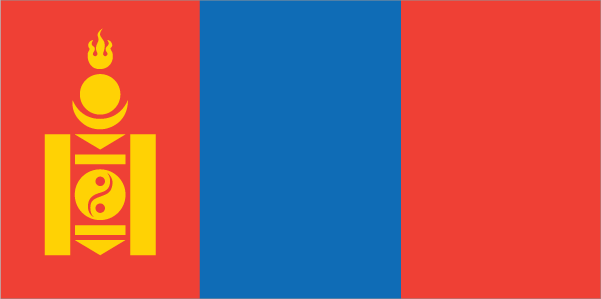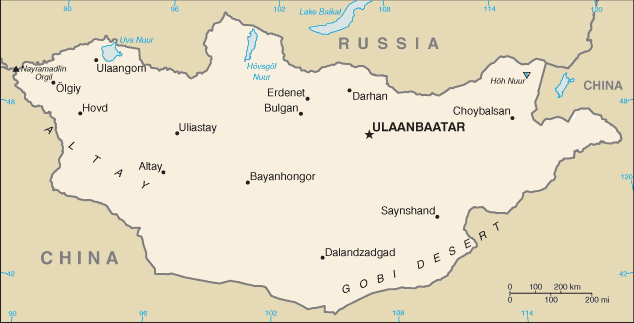|
Economy - overview:
|

|
|
Mongolia's extensive mineral deposits and attendant growth in mining-sector activities have transformed Mongolia's economy, which traditionally has been dependent on herding and agriculture. Mongolia's copper, gold, coal, molybdenum, fluorspar, uranium, tin, and tungsten deposits, among others, have attracted foreign direct investment. Soviet assistance, at its height one-third of GDP, disappeared almost overnight in 1990 and 1991 at the time of the dismantlement of the USSR. The following decade saw Mongolia endure both deep recession, because of political inaction and natural disasters, as well as economic growth, because of reform-embracing, free-market economics and extensive privatization of the formerly state-run economy. The country opened a fledgling stock exchange in 1991. Mongolia joined the World Trade Organization in 1997 and seeks to expand its participation in regional economic and trade regimes. Growth averaged nearly 9% per year in 2004-08 largely because of high copper prices globally and new gold production. By late 2008, Mongolia was hit hard by the global financial crisis. Slower global economic growth hurt the country's exports, notably copper, and slashed government revenues. As a result, Mongolia's real economy contracted 1.3% in 2009. In early 2009, the International Monetary Fund reached a $236 million Stand-by Arrangement with Mongolia and the country has largely emerged from the crisis with better regulations and closer supervision. The banking sector strengthened but weaknesses remain. In October 2009, Mongolia passed long-awaited legislation on an investment agreement to develop the Oyu Tolgoi mine, considered to be among the world's largest untapped copper deposits. Recent calls by nationalist politicians to renegotiate the investment agreement, however, have called into question the attractiveness of Mongolia as a destination for foreign direct investment. Negotiations to develop the massive Tavan Tolgoi coal field face similar obstacles. The economy grew by 6.4% in 2010, 17.5% in 2011, and by more than 12.3% in 2012, largely on the strength of commodity exports to nearby countries and high government spending domestically. Mongolia's economy, however, faces near-term economic risks from the government's loose fiscal policies, which are contributing to high inflation, and uncertainties in foreign demand for Mongolian exports. Trade with China represents more than half of Mongolia's total external trade - China receives more than 90% of Mongolia's exports. Mongolia purchases 95% of its petroleum products and a substantial amount of electric power from Russia, leaving it vulnerable to price increases. Due to severe winter weather in 2009-10, Mongolia lost 22% of its total livestock, and meat prices doubled. Inflation remained higher than 10% for much of 2010-12, due in part to higher food and fuel prices. The economic slowdown in China during 2011-2012 resulted in fewer Mongolian exports, a widened trade gap, and decreased government revenues, putting pressure on Mongolian fiscal policy. Remittances from Mongolians working abroad, particularly in South Korea, are significant.
|
|
|
GDP (purchasing power parity):
|

|
|
$15.17 billion (2012 est.)
country comparison to the world: 140
$13.51 billion (2011 est.)
$11.5 billion (2010 est.)
note:
data are in 2011 US dollars
|
|
|
GDP (official exchange rate):
|

|
|
$9.988 billion (2012 est.)
|
|
|
GDP - real growth rate:
|

|
|
12.3% (2012 est.)
country comparison to the world: 4
17.5% (2011 est.)
6.4% (2010 est.)
|
|
|
GDP - per capita (PPP):
|

|
|
$5,400 (2012 est.)
country comparison to the world: 151
$4,800 (2011 est.)
$4,200 (2010 est.)
note:
data are in 2011 US dollars
|
|
|
GDP - composition by sector:
|

|
|
agriculture: 14.6%
industry:
42.7%
services:
42.7% (2012 est.)
|
|
|
Labor force:
|

|
|
1.037 million (2011 est.)
country comparison to the world: 142
|
|
|
Labor force - by occupation:
|

|
|
agriculture: 33.5%
industry:
11.5%
services:
55% (2011)
|
|
|
Unemployment rate:
|

|
|
9% (2011 est.)
country comparison to the world: 102
13% (2010)
|
|
|
Population below poverty line:
|

|
|
29.8% (2011 est.)
|
|
|
Household income or consumption by percentage share:
|

|
|
lowest 10%: 3%
highest 10%:
28.4% (2008)
|
|
|
Distribution of family income - Gini index:
|

|
|
36.5 (2008)
country comparison to the world: 82
32.8 (2002)
|
|
|
Budget:
|

|
|
revenues: $4.409 billion
expenditures:
$5.238 billion (2012 est.)
|
|
|
Taxes and other revenues:
|

|
|
44.4% of GDP (2012 est.)
country comparison to the world: 33
|
|
|
Budget surplus (+) or deficit (-):
|

|
|
-8.3% of GDP (2012 est.)
country comparison to the world: 199
|
|
|
Inflation rate (consumer prices):
|

|
|
14% (2012 est.)
country comparison to the world: 210
10.2% (2011 est.)
|
|
|
Central bank discount rate:
|

|
|
13.25% (31 December 2012)
country comparison to the world: 15
12.25% (31 December 2011 est.)
|
|
|
Commercial bank prime lending rate:
|

|
|
18.6% (31 December 2012 est.)
country comparison to the world: 39
15.5% (31 December 2011 est.)
|
|
|
Stock of narrow money:
|

|
|
$1.314 billion (31 December 2012 est.)
country comparison to the world: 139
$1.247 billion (31 December 2011 est.)
|
|
|
Stock of broad money:
|

|
|
$5.456 billion (31 December 2012 est.)
country comparison to the world: 127
$4.592 billion (31 December 2011 est.)
|
|
|
Stock of domestic credit:
|

|
|
$5.007 billion (31 December 2012 est.)
country comparison to the world: 117
$4.04 billion (31 December 2011 est.)
|
|
|
Market value of publicly traded shares:
|

|
|
$1.29 billion (31 December 2012)
country comparison to the world: 100
$1.579 billion (31 December 2011)
$1.093 billion (31 December 2010)
|
|
|
Agriculture - products:
|

|
|
wheat, barley, vegetables, forage crops; sheep, goats, cattle, camels, horses
|
|
|
Industries:
|

|
|
construction and construction materials; mining (coal, copper, molybdenum, fluorspar, tin, tungsten, and gold); oil; food and beverages; processing of animal products, cashmere and natural fiber manufacturing
|
|
|
Industrial production growth rate:
|

|
|
7.2% (2012 est.)
country comparison to the world: 36
|
|
|
Current account balance:
|

|
|
-$2.354 billion (2012 est.)
country comparison to the world: 143
-$1.781 billion (2011 est.)
|
|
|
Exports:
|

|
|
$4.385 billion (2011 est.)
country comparison to the world: 120
$4.818 billion (2011 est.)
|
|
|
Exports - commodities:
|

|
|
copper, apparel, livestock, animal products, cashmere, wool, hides, fluorspar, other nonferrous metals, coal, crude oil
|
|
|
Exports - partners:
|

|
|
China 85.7%, Canada 6.3% (2011)
|
|
|
Imports:
|

|
|
$6.739 billion (2012 est.)
country comparison to the world: 112
$6.598 billion (2011 est.)
|
|
|
Imports - commodities:
|

|
|
machinery and equipment, fuel, cars, food products, industrial consumer goods, chemicals, building materials, cigarettes and tobacco, appliances, soap and detergent
|
|
|
Imports - partners:
|

|
|
China 43.4%, Russia 23.3%, South Korea 5.6%, Japan 5.1%, US 5% (2011)
|
|
|
Debt - external:
|

|
|
$2.564 billion (31 December 2011 est.)
country comparison to the world: 137
$2.505 billion (31 December 2010 est.)
|
|
|
Stock of direct foreign investment - at home:
|

|
|
$4.62 billion (31 December 2011 est.)
country comparison to the world: 86
$1.691 billion (31 December 2010 est.)
|
|
|
Stock of direct foreign investment - abroad:
|

|
|
$95 million (31 December 2011 est.)
country comparison to the world: 82
$62 million (31 December 2010 est.)
|
|
|
Exchange rates:
|

|
|
togrog/tugriks (MNT) per US dollar -
1,299.5 (2012 est.)
1,265.5 (2011 est.)
1,357.1 (2010 est.)
1,442.8 (2009)
1,170 (2007)
|
|
|
Fiscal year:
|

|
|
calendar year
|
|
|
|





 )
)



